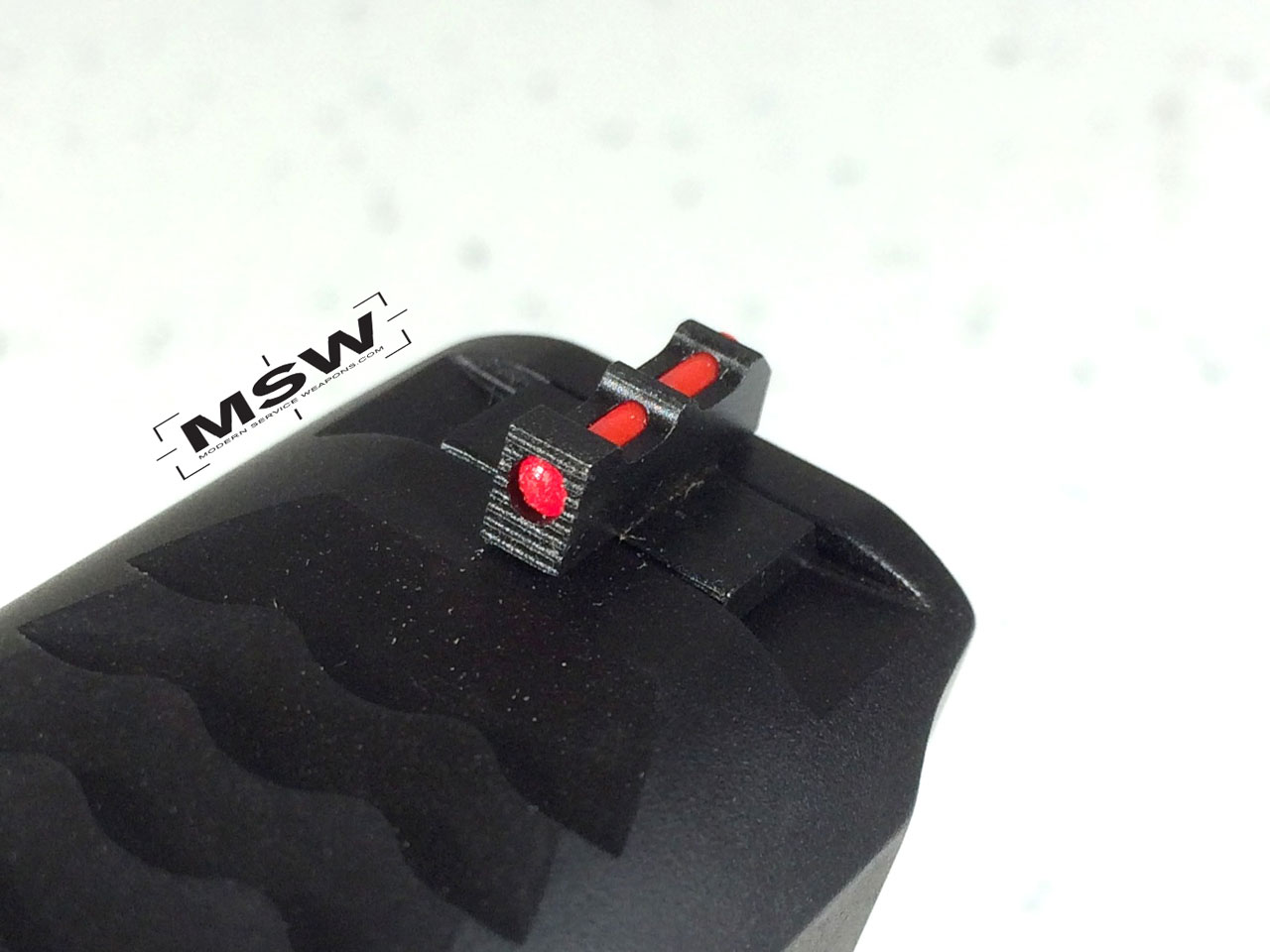
A properly designed fiber optic front is sufficiently durable for hard use. And in the unlikely event the fiber is damaged, the front sight blade is still usable.
Frequently, I am asked what sight configuration I prefer on a duty pistol. Most of those in law enforcement prefer tritium sights as that has what they have been taught as being the best to use in case of a low light encounter. While I am certainly not here to say that tritium inserts are a poor choice, they are not mine. My favorite choice of insert for a front sight is a fiber optic front with a black rear. I find that in most daytime lighting conditions, the front fiber is able to gather enough light to glow as bright as an Aimpoint dot. It is extremely easy and fast to acquire, and has held up quite well for me in work and off-work applications.
Recently, Frank Proctor posted an excellent article on this very topic on the RecoilWeb website. His article outlines some of the durability concerns as well as the advantages of the use of the fiber optics on pistol sights. The short of it is that if you’re carrying a pistol, you should have a light either with you, or attached to the gun. And if the fiber breaks or falls out, the front sight is just as usable as any set of non-illuminated irons.
Read Frank’s article HERE.



I agree with all that theory, but I still think your brass bead front is the best thing since sliced bread.
It isnt theory that I’ve been using fiber optic fronts on and off the job for a decade and have not had any problems. That said, brass/gold bead sights are a viable option and while they dont stand out as bright, they are visible in a broad band of lighting conditions.
Good articles. I prefer fiber optic sights on handguns with one exception, pocket carry handguns. Even inside a good pocket holster your weapon gets jostled around a bit. A C-more solid green or red front sight, brass bead or XS front sight are less likely to get skewed. In my case the C-more sights have worked for years on my SP-101 that rides in my jacket pocket everyday without issue. Just my two cents.
When I am asked by my coworkers to put night sights on their personal pistols they almost always ask for tritium night sights, since that is what they have been taught is appropriate for a working handgun. I believe in learning through applied science, so I take them into a room with a couple (unloaded) handguns and turn off the lights. Of course, they can see the tritium dots in total darkness. I then ask if they can see or identify their target in that condition, and the answer is of course, no. I then activate the pistol light and tell me if they can see their tritium dots. Again, the answer is no, since the light in the target washes out the faint glow of the tritium. This demonstrates that the tritium is pretty much useless. I then repeat the demonstration with the fiber optic front. So far, all but a few have switched to FO front sights afterwards.
This is, of course, what is known as a clue. Unfortunately, most cops are not gun people and have put as much thought into their duty pistol as they might the brand of fingerprint pad they were issued. And sadly, most LE firearms instructors simply parrot what they were taught by their instructors without any deeper understanding of the whys and hows.
During a 3 hour night shoot I had quite a bit of trouble picking up the sights while engaging multiple targets. A quality hand held flashlight was used. Either held above the head pointing toward the target or held near the side of the face lighting up the target and damn near washing out the gun.
Everyone was shooting Glocks with different sight set ups. Factory sights, 10-8 fiber optics, tritium sights, etc.
We started at about 30′. Targets were 8″ steel squares angled down. engaging and concentrating on reacquiring sight pictures, fundamentals etc.
We then placed targets 15′ apart and did multiple drills swinging / pivoting engaging each target.
We then proceeded to stop using flash lights and turned on a cars headlights. We could make out the target clearly, but the weapon was blacked out subdued by our shadow.
Surprisingly I found the tritium sight to give me the most reference and fastest acquisition . I was sold on my bro’s 10-8 u notch rear and fiber front but the night drills made me rethink how I need to train to properly use those sights.
Stance, index, fundamentals were constantly checked. It was a professional Mil class.
I personally need more time outdoors w/ a handheld light and any type of sights. The surefire mounted on my home defense pistol lights up the whole room or hallway creating A ton lot light to easily pick up any type of sights.
For me it changed drastically outdoors when the light wasn’t bouncing off of walls and was beamed directly to the target or slightly offset.
KT
There are lighting conditions where tritium is superior, to be sure. But they are narrow and there are workarounds. Nothing is better 100% of the time. But FO is advantageous for me for the majority of situations I have found myself in.
All my glocks but one have night front site and black rear, exception is a f/o front I am trying to warm up to per you and hilton’s articles.